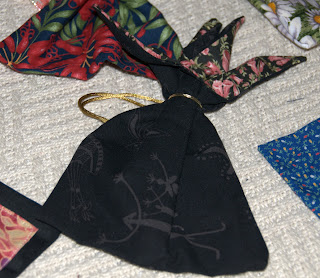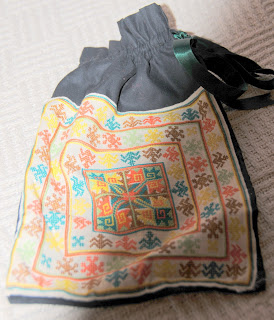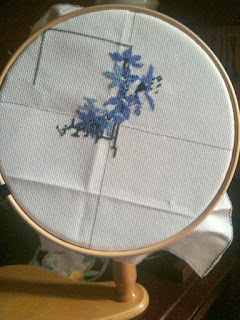This is a project I have been working on for over a year. I bought a little Semco Cross-stitch kit of a Margaret Preston painting from the National Gallery of Australia. Only 15cm square, it was interesting to do and reflected the colours and shapes of her work very well. It is also terrific to be working with Australian rather than European flowers.
I liked this so much I went looking for another three similar kits to use as the panels on a four-sided work-bag/ necessaire. I have made a couple of these and really like the making and the useful end product.
I couldn't get the kits online from the NGA, but found them on eBay from chiton11, very reasonably priced.
I have now completed two more.
This one has an almost 3D effect from the waratah in particular, presumably from the black background.
The Cinerarias are not especially Australian, but the composition and vase are unmistakably Margaret Preston's.
I am now working on the last one, simply called 'Still Life'. It is very blue.
I hope the bag will look good. I will update this post as I progress from here. If it works, I have a few more ideas for similar bags using other cross-stitch designs.
22 October.
Still Life is still progressing. There is an interesting overlay to come - green back stitch over the top of black cross stitch.
Sunday 31 October
I have found the flowers overlapping the base of the vase quite a challenge. It involves quite stitches that divide the units of the aida fabric - where four stitches are required in a square, using two different colours. The chart looks like this:
Adjunct Senior Research Fellowship (Honorary) UniSA
In the end I have found it easier to follow the picture of the finished product, in order to understand what effect is being achieved. Essentially it is the sense of the edge of the flower (especially the flannel flower) against the black background. It is much the same effect as outline stitch on the flowers above the vase.
I now have most of that section finished. I am now trying to define the limits of the major sections left.
I finished this piece over the weekend. It took quite a while to complete the outlining of the flowers above and around the vase, but makes such a difference - giving a 3D effect.
Now all I have to do is make the bag!
6 December
The bag is finished. In spite of my best effort with exact measuring, two outside pockets do not quite line up, but otherwise I am happy. I used black linen from my mother's stash as the main bag fabric and found a perfect lining fabric in my stash - Australian wildflowers printed on black fat quarter purchased from the Australian collection of the One Stop Fabric Shop (www.onestopfabricshop.com.au).
Using a fat quarter meant shaping the lining differently to the bag, but it worked well.
 Another group were made from cotton, using as a pattern a bag I bought from an sale at the Embroiders' Guild of SA. This uses a curtain ring on a long tab as closure.
Another group were made from cotton, using as a pattern a bag I bought from an sale at the Embroiders' Guild of SA. This uses a curtain ring on a long tab as closure.




















 This is a cushion kit, already assembled in a cotton/modal mix, from Belgium. The embroidery is all stem stitch, in two colours - a light olivey-green and a silvery-grey. The fabric is even weave, making it easy to get an even stitch length. It has a nice continuity of line, quite Eastern in effect.
This is a cushion kit, already assembled in a cotton/modal mix, from Belgium. The embroidery is all stem stitch, in two colours - a light olivey-green and a silvery-grey. The fabric is even weave, making it easy to get an even stitch length. It has a nice continuity of line, quite Eastern in effect.


























